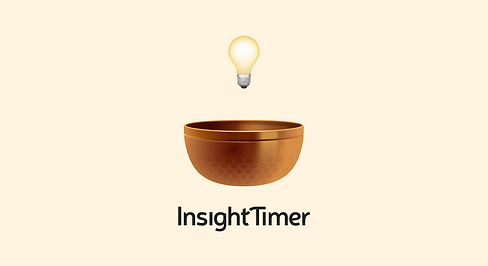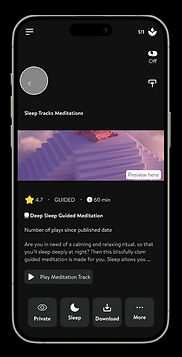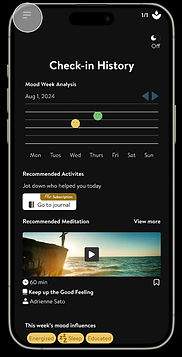


Get to Know Us
Insight Timer is the #1 free meditation app. The application includes guided meditations and sleep music tracks from world-renowned artists. Additionally it includes guided talks by meditation and mindfulness experts, neuroscientists, psychologists and teachers from Stanford, Harvard, the University of Oxford and more.
Project Goal
This project aimed to redesign key InsightTimer features after a heuristic evaluation revealed clutter, too many options, and poor navigation. We focused on making the app more intuitive and improving access to sleep tracks and mood tracking. Usability tests compared the original and redesigned versions to evaluate ease of use. This presentation covers our methods, findings, and a demo of the improved interface.
Recruitement &
Target Users
We tested Insight Timer with first-time users aged 18 – 28, focusing on students managing stress and sleep challenges. Participants needed English proficiency, a touchscreen smartphone, reliable internet, and no prior app experience. Alongside in-class pilots, we tested four external users to capture authentic, real-world feedback.
Education
👤
USER GROUP
Wellness enthusiasts
#️⃣
AGE
18 - 28
🌎
DEMOGRAPHICS
Post-secondary Students
User Testing Methodologies
We conducted remote, one-on-one A/B testing comparing the original Insight Timer app (Interface A) with our Figma prototype (Interface B), randomizing the order for each user. Using a think-aloud, scenario-based method, participants completed tasks on the Sleep Tracks and Mood Check-in pages—like finding a meditation, completing a check-in, and viewing mood history—while explaining their actions. We began with a “look and feel” assessment and asked standardized follow-up questions after each task. Sessions were audio recorded for transcription, with moderators taking notes using a structured script.
Quatric Screener (2 min)
Screening questions to recruit participants with similar demographics
Look & Feel Test (4 min)
4 minutes allocated to explore both the original app and the prototype
4o
AB Testing (4 min)
Test both Sleep Tracks and Mood Check-in features in the original app and the prototype for comparison.
Data Analysis Methodology
Our data analysis methodology prioritized participant privacy by anonymizing all data. We used a bottom-up approach, coding transcripts to identify key themes, issues, and insights. Findings were synthesized through affinity mapping in FigJam using digital sticky notes, and group discussions helped determine necessary updates to the prototype.
Transcriptions
Transcribed user testing audio recording
Google Sheets Coding
Anonymized Participants and coded feedback in Google Sheets.
Affinity Diagram
Put codes from Google Sheets into larger themes
Navigating this is confusing
All users found the horizontal menu layers on the Sleep page confusing and redundant—reflected by a high-severity heuristic rating—while the prototype’s simplified vertical scroll received positive feedback.
App Interface is Cluttered & Overwhelming
Most users found the original Insight Timer app was cluttered and overwhelming, validating our heuristic analysis
Can I customize it?
Overall, users valued customizability in the app. One wanted to log pets as a mood factor—missing in the original app—while another requested a customizable color scheme. In response, our prototype included an “other” option for users to add personal experiences and emotions. Although one user found the check-in process cluttered, they appreciated that the extra steps were optional.
Design Recs
Light & Dark Toggle Button
Customizable light and dark mode (easy to toggle), because of the contrasting insight on how some users preferred dark mode whilst some did not. We thought, we can give you both, and give you the choice.
Farewell to Next Step Button
Based on feedback that the Mood Check-In page felt cluttered and confused two users, we removed the “click for next steps” button and combined the emoticon and reason selection into a single screen to reduce clicks and simplify the flow.
Homepage Menu Tabs for Mood Check-in
To improve navigation, we added “Mood Check-In” and “Mood Check-In History” tiles to the homepage for easier access, replaced the bottom nav bar with a simplified hamburger menu to reduce confusion, and added clickable arrows to the Sleep Tracks page to avoid overwhelming users with an infinite scroll.
Insight Timer App Solutions

Feature 1:
Sleep Track
-
Presenting demo of solutions for InsightTimer features:
-
Sleep Tracks
-
Mood Check-In
-
Mood Check-In History
-
-
Added numbered pages with arrow buttons to address infinite scroll issue and improve navigation
Feature 2:
Mood Check-In
-
We also redesigned the flow into a two-step process to simplify the overall journey and reduce cognitive load. By breaking the task into smaller, more manageable parts, users can move through the experience with greater clarity and ease, ultimately making the interaction more intuitive and less overwhelming.


Feature 3:
Mood Check-in History
-
For the Check-In History feature, participants previously took longer to locate it due to the less intuitive chevron button hidden in the menu. To address this usability issue, we introduced the following solutions to make access more visible, direct, and user-friendly.
Main Takeaways
To help users easily find tailored meditations and support long-term wellness, InsightTimer must meet modern navigation standards. Usability testing of Sleep Tracks and Mood Check-In revealed key improvements to enhance discoverability and guide users to relevant content more efficiently.
1
InsightTimer navigation maintenance for the location of user meditation interest
2
User Testing is essential to increase efficiency and completion of user goals
3
InsightTimer should be able to enhance users’ health, wellness and meditation practices.